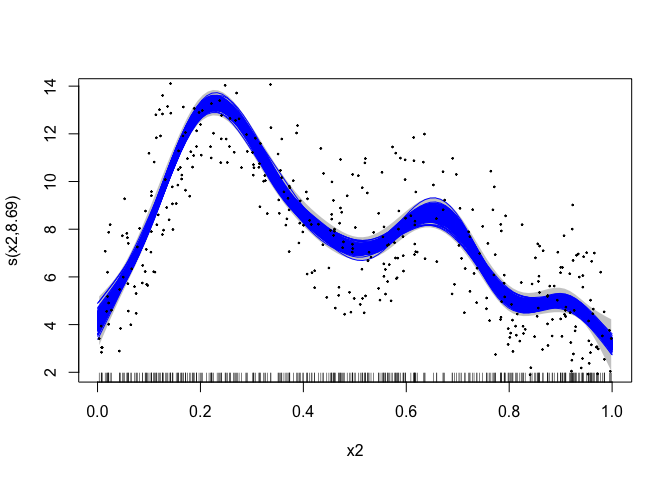greta.gam lets you use mgcv’s smoother functions and formula syntax to define smooth terms for use in a greta model. You can then define your own likelihood to complete the model, and fit it by MCMC.
This is work in progress!
Here’s a simple example adapted from the mgcv ?gam help file:
In mgcv:
library(mgcv)
#> Loading required package: nlme
#> This is mgcv 1.9-1. For overview type 'help("mgcv-package")'.
set.seed(2)
# simulate some data...
dat <- gamSim(1, n = 400, dist = "normal", scale = 0.3)
#> Gu & Wahba 4 term additive model
# fit a model using gam()
b <- gam(y ~ s(x2), data = dat)Now fitting the same model in greta:
library(greta.gam)
#> Loading required package: greta
#>
#> Attaching package: 'greta'
#> The following objects are masked from 'package:stats':
#>
#> binomial, cov2cor, poisson
#> The following objects are masked from 'package:base':
#>
#> %*%, apply, backsolve, beta, chol2inv, colMeans, colSums, diag,
#> eigen, forwardsolve, gamma, identity, rowMeans, rowSums, sweep,
#> tapply
set.seed(2024 - 02 - 09)
# setup the linear predictor for the smooth
z <- smooths(~ s(x2), data = dat)
#> ℹ Initialising python and checking dependencies, this may take a moment.
#> ✔ Initialising python and checking dependencies ... done!
# set the distribution of the response
distribution(dat$y) <- normal(z, 1)
# make some prediction data
pred_dat <- data.frame(x2 = seq(0, 1, length.out = 100))
# z_pred stores the predictions
z_pred <- evaluate_smooths(z, newdata = pred_dat)
# build model
m <- model(z_pred)
# draw from the posterior
draws <- mcmc(m, n_samples = 200)
#> running 4 chains simultaneously on up to 8 CPU cores
#> warmup 0/1000 | eta: ?s warmup == 50/1000 | eta: 30s warmup ==== 100/1000 | eta: 17s warmup ====== 150/1000 | eta: 12s warmup ======== 200/1000 | eta: 10s warmup ========== 250/1000 | eta: 8s warmup =========== 300/1000 | eta: 7s warmup ============= 350/1000 | eta: 6s warmup =============== 400/1000 | eta: 5s warmup ================= 450/1000 | eta: 5s warmup =================== 500/1000 | eta: 4s warmup ===================== 550/1000 | eta: 4s warmup ======================= 600/1000 | eta: 3s warmup ========================= 650/1000 | eta: 3s warmup =========================== 700/1000 | eta: 2s warmup ============================ 750/1000 | eta: 2s warmup ============================== 800/1000 | eta: 1s warmup ================================ 850/1000 | eta: 1s warmup ================================== 900/1000 | eta: 1s warmup ==================================== 950/1000 | eta: 0s warmup ====================================== 1000/1000 | eta: 0s
#> sampling 0/200 | eta: ?s sampling ========== 50/200 | eta: 1s sampling =================== 100/200 | eta: 0s sampling ============================ 150/200 | eta: 0s sampling ====================================== 200/200 | eta: 0s
# plot the mgcv fit
plot(b, scheme = 1, shift = coef(b)[1])
# add in a line for each posterior sample
apply(draws[[1]], 1, lines, x = pred_dat$x2, col = "blue")
#> NULL
# plot the data
points(dat$x2, dat$y, pch = 19, cex = 0.2)
greta.gam uses a few tricks from the jagam (Wood, 2016) routine in
mgcv to get things to work. Here are some brief details for those
interested in the internal workings…
GAMs are models with Bayesian interpretations (even when fitted using “frequentist” methods). One can think of the smoother penalty matrix as a prior precision matrix in a Bayesian random effects model. Design matrices are constructed exactly as in the frequentist case. See Miller (2021) for more background on this.
There is a slight difficulty in the Bayesian interpretation of the GAM
in that, in their naïve form the priors are improper as the nullspace of
the penalty (in the 1D case, usually the linear term). To get proper
priors we can use one of the “tricks” employed in Marra & Wood (2011) –
that is to somehow penalise the parts of the penalty that lead to the
improper prior. We take the option provided by jagam and create an
additional penalty matrix for these terms (from an eigen-decomposition
of the penalty matrix; see Marra & Wood, 2011).
Marra, G and Wood, SN (2011) Practical variable selection for generalized additive models. Computational Statistics and Data Analysis, 55, 2372–2387.
Miller DL (2021). Bayesian views of generalized additive modelling. arXiv.
Wood, SN (2016) Just Another Gibbs Additive Modeler: Interfacing JAGS and mgcv. Journal of Statistical Software 75, no. 7